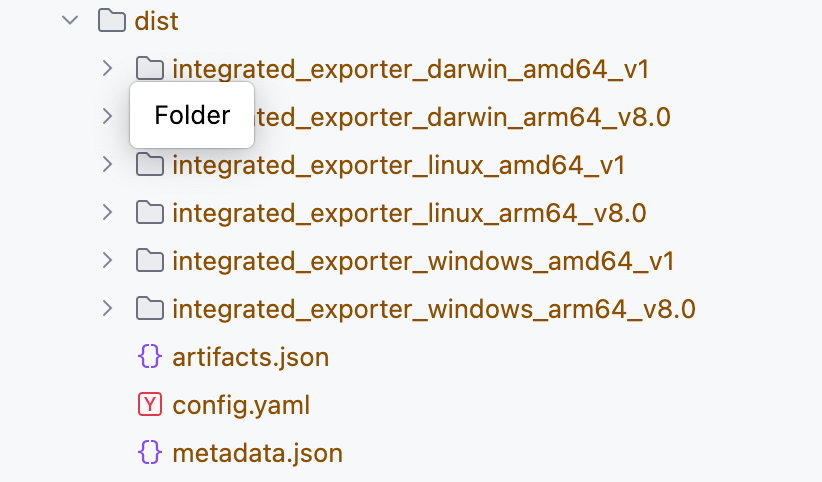release-ci
记录如何通过Github-ci来实现自动打包和发布go程序二进制包和docker镜像。
二进制包
go程序的二进制打包可以通过go-releaser来实现,官网在这。
1 创建go-releaser配置文件
在项目的根目录下创建.goreleaser.yaml文件。根据需要配置好需要打包的文件。
下面给出一个配置推荐:基本够用了
version: 2
#project_name: myproject
# Default: './dist'.
#dist: another-folder-that-is-not-dist
before:
hooks:
- go mod tidy
builds:
-
env:
- CGO_ENABLED=0
# gcflags:
# - 'all=-N -l'
goos:
- linux
- windows
- darwin
goarch:
- amd64
- arm64
archives:
- format: tar.gz
# this name template makes the OS and Arch compatible with the results of `uname`.
name_template: >-
{{ .ProjectName }}_
{{- title .Os }}_
{{- if eq .Arch "amd64" }}x86_64
{{- else if eq .Arch "386" }}i386
{{- else }}{{ .Arch }}{{ end }}
{{- if .Arm }}v{{ .Arm }}{{ end }}
# use zip for windows archives
format_overrides:
- goos: windows
format: zip
changelog:
filters:
exclude:
- "^docs:"
- "^test:"
- "^debug:"
force_token: github
2 本地尝试发布
可以在本地使用go-releaser程序来判断配置文件是否有问题,打出来的包是否可运行。当然也可以直接到线上测试hh
安装go-releaser,注意,要求go的版本在1.23.4及以上。
go install github.com/goreleaser/goreleaser/v2@latest
然后检查配置文件:
goreleaser check
然后打包文件,注意打包的时候,它是根据git操作来实现的,因此在你打包之前,需要先提交本地修改,并且创建一个tag
goreleaser build --clean # clean会清理之前打包的

可以看到根目录多了个dist目录,然后里面就是他打包的可执行文件。

3 使用action发布
创建一个新的action即可,下面是一个样例,给予写权限和传递GITHUB_TOKEN。
name: go-releaser-ci
on:
push:
# run only against tags
tags:
- v*
permissions:
contents: write
jobs:
releaseProgram:
runs-on: ubuntu-latest
steps:
- name: Checkout
uses: actions/checkout@v4
with:
fetch-depth: 0
- name: Set up Go
uses: actions/setup-go@v5
with:
go-version: '1.23.4'
- name: Run GoReleaser
uses: goreleaser/goreleaser-action@v6
with:
distribution: goreleaser
args: release --clean
env:
GITHUB_TOKEN: ${{ secrets.GITHUB_TOKEN }}
然后,你就可以提交一个tag了,这样github会自动执行这个action,然后进行打包。
然后在releases下,就可以看到发布的版本包了

docker镜像
虽然go-releaser也有打包镜像功能,最好还是使用专用的docker-action吧
1 编写Dockerfile文件
这个就根据自己的需要编写即可
注意这里取了巧,我们将这个发布docker镜像和发布release放在一个action执行,我们就可以直接利用go-releaser打得二进制包,他的路径可以在github-action的执行日志中找到,下面的COPY指令的源二进制路径就是在日志中找到的。其实通过本地的尝试,也可以知道他就是在dist目录下。
# Use official Golang image with Alpine for a lightweight base
FROM golang:alpine
# Set environment variables
ENV CGO_ENABLED=0
# Add image metadata
LABEL org.opencontainers.image.title="integrated_exporter" \
org.opencontainers.image.description="Integrated Exporter" \
org.opencontainers.image.url="https://github.com/liushunkkk/integrated_exporter" \
org.opencontainers.image.documentation="https://github.com/liushunkkk/integrated_exporter#readme" \
org.opencontainers.image.source="https://github.com/liushunkkk/integrated_exporter" \
org.opencontainers.image.licenses="Apache-2.0 license" \
maintainer="liushun <liushun0311@zju.edu.cn>"
# Set the working directory
WORKDIR /app
# Copy binaries for different architectures
COPY dist/integrated_exporter_linux_amd64_v1/integrated_exporter /dist/integrated_exporter_linux_amd64/integrated_exporter
COPY dist/integrated_exporter_linux_arm64_v8.0/integrated_exporter /dist/integrated_exporter_linux_arm64/integrated_exporter
# Select the appropriate binary based on the architecture
RUN if [ "$(go env GOARCH)" = "amd64" ]; then \
cp /dist/integrated_exporter_linux_amd64/integrated_exporter ./integrated_exporter; \
elif [ "$(go env GOARCH)" = "arm64" ]; then \
cp /dist/integrated_exporter_linux_arm64/integrated_exporter ./integrated_exporter; \
fi
# Install dependencies and clean up
RUN apk update --no-cache \
&& apk add --no-cache tzdata ca-certificates \
&& rm -rf /dist /go/pkg/mod /go/pkg/sumdb
# Copy configuration files
COPY etc/etc.yaml ./etc/etc.yaml
COPY etc/.env.yaml ./etc/.env.yaml
# Expose the application port
EXPOSE 6070
# Set the default command
ENTRYPOINT ["./integrated_exporter", \
"server", \
"--port=6070", \
"--config=./etc/etc.yaml", \
"--env=./etc/.env.yaml"]
2 编写action
我们在上一个action上追加即可,具体的配置可以去各个action的仓库的文档查看。
name: go-releaser-ci
on:
push:
# run only against tags
tags:
- v*
permissions:
contents: write
jobs:
releaseProgram:
runs-on: ubuntu-latest
steps:
- name: Checkout
uses: actions/checkout@v4
with:
fetch-depth: 0
- name: Set up Go
uses: actions/setup-go@v5
with:
go-version: '1.23.4'
# - name: Set up Docker # macos 没有预装 docker,且只支持 macos-13
# uses: docker/setup-docker-action@v4
# env:
# LIMA_START_ARGS: --cpus 4 --memory 8
- name: Run GoReleaser
uses: goreleaser/goreleaser-action@v6
with:
distribution: goreleaser
args: release --clean
env:
GITHUB_TOKEN: ${{ secrets.GITHUB_TOKEN }}
- name: Get version
id: get_version
run: echo VERSION=$GITHUB_REF_NAME >> $GITHUB_OUTPUT
- name: Log in to Docker Hub
uses: docker/login-action@v3
with:
username: ${{ vars.DOCKER_HUB_USERNAME }}
password: ${{ secrets.DOCKER_HUB_PASSWORD }}
- name: Login to GitHub Container Registry
uses: docker/login-action@v3
with:
registry: ghcr.io
username: ${{ github.repository_owner }}
password: ${{ secrets.ACCESS_PACKAGE_TOKEN }}
- name: Set up QEMU
uses: docker/setup-qemu-action@v3
- name: Set up Docker Buildx
uses: docker/setup-buildx-action@v3
- name: Docker build and push
uses: docker/build-push-action@v6
with:
context: .
platforms: linux/amd64, linux/arm64
push: true
tags: |
liushun311/integrated_exporter:latest
liushun311/integrated_exporter:${{ steps.get_version.outputs.VERSION }}
ghcr.io/liushunkkk/integrated_exporter:latest
ghcr.io/liushunkkk/integrated_exporter:${{ steps.get_version.outputs.VERSION }}
3 注意点
1、最好使用ubuntu-latest进行发布,因为它自带了docker程序,如果使用mac的话,还需要再引入一个setup-docker-action,并且这个action在latest上不支持,需要是macos-13才支持。可以看支持的机器。
2、登陆GitHub Container Registry的时候,password最好自己在设置里创建personal access token,赋予package的所有权限,文档里写的可以用GITHUB_TOKEN,但是我尝试的时候是不行的,不知道哪出了问题,还是直接创建PAT省事。
3、Dockerhub需要创建账号,然后需要注意自己命名空间,不是昵称,是可以用于登陆的用户名。
4 结果
dockerhub

github的ghcr是需要配置的,才能在仓库的packages里显示。

在packages里,然后右下角进入你的package的设置,在里面绑定package的项目即可。
